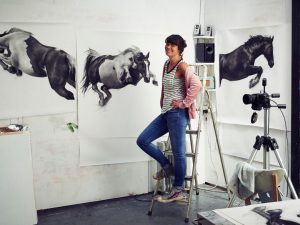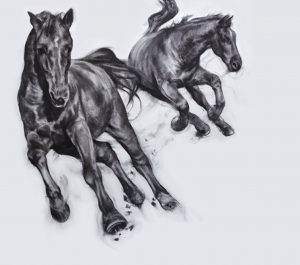Allow us to introduce and shed an artist spotlight on the lady behind the Rhythm & Movement exhibition, Patsy McArthur.
Patsy is a figurative artist who focuses on portraying the concept pf escapism within her work. Drawing is Patsy’s chosen and favoured medium, as it allows her to be direct with her work and enjoys the feel of the monochrome effect as it allows focus on the image without getting distracted by the seduction of colour.
The collection that will be presented in the Rhythm & Movement exhibition will consist of horses in motion, which captures the physicality of the animal as well as its momentum and spirit.
I got the opportunity to interview Patsy in order to find out more about the artist and the inspiration behind the theme of horses and the monochrome, motion style of these limited edition pieces that will be presented in the Rhythm & Movement exhibition.
The Interview
TBG: What is the story/theme/inspiration/idea behind your work/collection?
Patsy: In terms of the content of my drawings, I have always had an interest in the notion of escapism and images associated with freedom appeal to me – so using the figure in the context of jumping, flying and falling are visually powerful for me but also hopefully make the viewer feel a certain way as a human being. In some works, the figure in motion – horse or human – has a very powerful feel to it – a feeling of progress or moving forward is something which makes me feel strong mentally and I think and hope that others get the same feeling from the work.
Having previously worked only with the human figure, a trip to my sister’s horse competition yard in Scotland a couple of years ago got me thinking about how I could use the horse in motion as a subject for a new series of work. Since that first trip in 2016, I’ve returned time and again to shoot film and stills which I then use as source material for my drawings in the studio.
“I’m trying to make really contemporary, emotional drawings which have as much to do with us as humans as they do with horses; we see ourselves in them. The imagery of leaping joyously, straining to clear an invisible fence, spooking or swerving all seem to translate into our human experience so well and by keeping the images monochrome and free of background context, focus one on the content. They are highly rendered drawings describing snapshots of movement in timeless black and white.”
TBG: What influences your work? E.g. Artists/Movements/certain works/historic time
Patsy: Being Scottish and having trained at art school in Scotland, during my education I was surrounded by the long tradition of Scottish figurative painting and I was blown away by the work of the “New Glasgow Boys “ from the 80s /early 90s when I was a teenager. It was raw and, in your face, and very human. Figurative painting appealed to me more than any other type of art – I saw the power it had to connect emotionally – at a human level.
This, combined with the rigorous training in life drawing that we had at Scottish art schools meant that I had the observational drawing skills to really develop my work in realism and I have made realist figurative work ever since and continue to push my draftsmanship as far as I can.
TBG: What is your favourite type/genre of art?
Patsy: As above, the type of work which I admire the most is figurative drawing and painting for its ability to connect emotionally, although while it’s not something I do myself, I also have a love of colourful abstract painting.
TBG: What does art mean to you and did it influence you to make art a professional vocation?
Patsy: Like many artists, I use my work as a form of therapy. It helps me to work through psychological states and the headspace I use for making art feels like my personal sanctuary. The images that I make often help me to feel mentally strong and powerful, or calm and comforted or there’s simply some sort of catharsis that happens through making a piece. The beauty of being able to make art full-time is that by developing as an artist and getting your work out there, you can share your work with a wide audience and it can connect emotionally with others.
TBG: How has your work grown since you started out as an artist?
Patsy: There’s no doubt that my work has developed in skill, particularly my painting work. It has also become more focused in terms of what I want to achieve and hopefully it’s more successful for that. I used to work solely with the male model for many years, now I use both women and men, and as well as the horse! My early work had a narrative element which currently isn’t present, but it could be something that I revisit. I like the fact that ideas and inspiration bounce and boomerang back and forward on the timeline – I’ve been making work consistently for 20 years so it’s not a straightforward trajectory, there’s is still a consistency to themes that travel with me from my past that makes my art mine.
TBG: What do you feel makes your style of work unique?
Patsy: My commitment to drawing is very strong, and the fact that I make large, fully worked drawings as opposed to drawings as precursors for paintings is not something that too many artists do. Also my commitment to the figure in motion has been very consistent in recent years, it’s not something I tire of, nor is my love of drawing in charcoal. My work is generally fairly large in scale, it’s bold, powerful and has impact and easily recognisable that it’s mine. I don’t shy away from subjects that are difficult to draw or paint – my work with the horse in motion and the work that I do with the figure underwater are good examples of subjects that are very challenging technically and not many artists tackle them, so again I’m fairly unusual in that regard!
TBG: What type of art do you dislike and why?
Patsy: I dislike work that I find difficult to connect with emotionally. Work which I find too conceptual, that is more intellectual than emotional.
TBG: What can we expect to see in the future?
Patsy: I am increasingly interested in the subject of water and wellbeing, and I would like my work with open water swimmers to develop into a project that looks at its link with mental health. I plan to make some really large drawings for exhibition next year with wild swimmers out on the surface of the open sea from a surface perspective and interview some of my models for an exhibition of words and images.
TBG: What quote/word sums up your art work?
Patsy: Dynamic, powerful, brave.
TBG: Tell us about your creative process; how do your works come into creation? Where do you begin? Do you envisage the final outcome from the start or is the process more of a journey?
Patsy: I generally have an idea of something that I would like to explore, that would give me an interesting perspective visually – the figure on a trampoline, a horse free- jumping a fence, figures running full pelt towards me, divers entering the water.. And from there, I will do what it takes to set up a photoshoot to achieve the images I’d like to get.
It’s a long process, especially when you have to consider who to use as a model, how they are clothed, where it takes place, lighting, weather, equipment etc.
I have a rough idea at this stage of the kind of images that might work well for a drawing or painting, but during the course of the shoot, some interesting things will generally happen, and it might go off course a bit organically. The photos don’t have to be amazing, sometimes I’ll hire a photographer to help me if I need one, but often I will just shoot some video and take some stills myself. If the photographic material isn’t such great quality, there is sometimes more room for the drawing or painting to develop in the studio. It isn’t about copying the photographic material but changing it into something else in the process. I’ll often have up to a thousand images to consider from a shoot and there are always unusual angles and perspectives that I would never have considered in my head beforehand. Back in the studio, I might work from many, many stills to make one drawing.
The exhibition will be up in our Shenfield gallery from the 11th January to the 8th February. Patsy’s work that will be displayed in the exhibition will then be available to browse and purchase on our website from the start of her exhibition.
Thank you to Patsy McArthur for taking the time to answer our questions. Be sure to go browse her pieces at http://interiorangle.co.uk/



